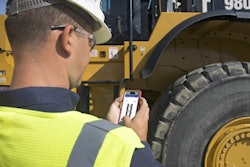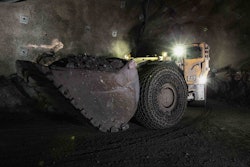
Imagine you’re the chief of operations for a big construction company. You have three projects underway, dozens of machines and workers to keep up with. Just before you leave the house in the morning, you open your laptop to check on the status of those projects on your telematics reporting system.
Project A and B are good. Green lights on both. But when you click on project C, you get a flashing red light, indicating the potential for safety issues. Drill down further and you discover:
• A supplier dropped the rebar off last night, weeks early, right in the middle of the dirt work.
• The site supervisor who’s been on this project since day one called in sick. Another supervisor who’s never seen the job is on his way to fill in, but arriving late.
• Of the operators manning four machines and three trucks on the site, only two of them have more than a year’s experience.
• Predicted weather conditions may limit visibility.
It may sound like just another chaotic day in the world of construction, but your telematics system is equipped with AI, artificial intelligence, sometimes called “machine learning.” As all this information enters the system, the AI algorithms compute the probability of an accident in these conditions at 60 percent. Not good.
So you email the new supervisor to hold fire, ping the shop to get a set of forks out there to move the rebar and head for the project instead of the office to assess the situation. There you talk to the crews and conduct a site-specific safety briefing.
Your telematics AI algorithms register these changes and drop the threat threshold below the company redlines. The threat potential of an accident – something no individual human could have possibly predicted – is eliminated. And it’s not even 8 a.m. yet.
Fantasy or the future?
The construction industry, thanks to advances in technology and telematics, is at the cusp of creating scenarios just like this.
According to Mika Majapuro, director of product management and strategy at Teletrac Navman, the scenario described above is still on the bleeding edge but definitely the direction the industry is headed. And telematics provides the information the machines, in this case computers, need to learn.
Machine learning is basically about looking for patterns, Majapuro says. “What was the job type? What was the weather? How many people were there? What was their skill level? You can go as deep as you want.”
The contractor or fleet manager’s responsibility in making this a reality is inputting data, lots of data. “In teaching machines to learn something, you have to show cases where accidents happen and cases where they didn’t happen,” Majapuro says.
Teletrac Navman’s sister company, Predictive Solutions, has been doing machine learning for some time, says Majapuro. “You buy it as software as a service (SaaS),” he says. “They work with the customer to figure out their goals and get all the data. Then they run the model for you and provide the dashboards.”
Gamification
In addition to machine learning and predictive analytics, “gamification” is another trend reshaping the telematics environment, says Pete Allen, chief client officer, MiX Telematics.
The over-the-road trucking industry is already using gamification to help improve driver safety and efficiency, he says. “I don’t see gamification as much in the construction world, although there are certainly pockets of it,” he says.
Gamification is simply putting all the driver’s behavior and metrics – things like speeding, harsh braking/acceleration, swerving and fuel economy – into a telematics dashboard and letting drivers and operators see how they compare to others. “The focus is to reduce crashes, but a lot of our customers like to make safety fun. If you put incentives around it or make a game out of it, it creates more awareness,” says Allen. “People will strive on their own to be safer drivers.”
Non-powered assets
The tracking of non-powered or non-mobile assets is another application the most advanced users of telematics systems are deploying to their benefit. Using QR codes and RFIDs, you can track things like light towers, generators, hand tools, conex boxes and trailers. “By tagging non-powered assets, you can build processes to take better care of your equipment,” says Majapuro.
Hand tools and other items tend to get stolen or lost, especially on large jobsites and sites where there are multiple subs and vendors coming and going all day. Oil and gas drilling sites are often large and full of expensive tooling and equipment, which is why some of their managers are starting to track their non-powered equipment, says Allen.
Company-wide integration
Many people view telematics at this stage in its evolution as merely a way to keep tabs on trucks, equipment and maintenance. But the most value and the next step in telematics is to disseminate and integrate the information to your whole business, says Josh DeCock, product management director, Pedigree Technologies.
“Changing your business is the hardest thing to do, but it’s also the most impactful,” DeCock says. “The companies that are going to the next level are those that push data into every department they have – maybe people who have never seen the telematics data. If you can save these employees time, they’re interested.”
Bidding and estimating people can sharpen their quotes with accurate equipment cost information and save time by not having to slog through paper records from the shop.
And eliminating the need for office staff to record employee hours and other personnel information can significantly cut labor costs. “Having that allows your data to flow to the back-end system so that no one has to manually type in that data – that’s some of the low-hanging fruit where you can get a lot of ROI,” says Majapuro.
Collaboration and consultation
While there are certainly many plug-and-play telematics systems on the market today, more advanced users are looking for broader functionality, and collaboration with their vendors, Allen says.
“In the contractor world, most companies go into it with the idea of just tracking assets and maximizing equipment life and getting maintenance information,” says Allen. “There is more they can do; they just don’t know it. One of the things we’ve done is align our resources to our customers’ business objectives. We help them achieve their objectives by making sure they’re looking at the right reports or dashboards or even measuring specific ROI items collectively together to help them become power users of the system.”
Formal consultations occur at least quarterly, says Allen. More frequent contact may be recommended proactively, depending on circumstances. “You keep your customers happy by helping them maximize the information they’re getting to better their business, to get a stronger ROI or a better experience for their end customers. We have to become service providers as well as technology platforms.”
Future tech
The nuts and bolts of telematics technology is not super-sophisticated. Basic machine sensors or humans input information, and the software disseminates the information via the cloud or the web to whoever needs it. But there are a handful of advanced technologies that may become incorporated into telematics in the future, and these hold even more promise.
Cameras are already being used in some mining applications that analyze a driver’s face to detect head and eye movements and automatically alert managers about over-tired employees. Collision avoidance technology and the same collision avoidance systems being used in autonomous and semi-autonomous passenger cars could be easily integrated into an off-road telematics system.
For the near term, however, there are many advantages from vendors creating better dashboards that help to interpret the data and provide more actionable data, says Majapuro. “That will be a big step forward.”
DeCock adds that the full adoption of universal telematics data standards will also help drive adoption. While acknowledging the progress being made with the Association of Equipment Management Professionals Telematics Standard 2.0, the industry’s codes are not as uniform as they could be. “That would make life for the contractors much easier,” he says. “But that dream or vision is still being found.”












